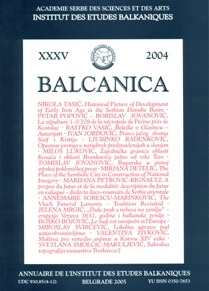Molitve pro remedio animae u Kotoru XIV veka
Prayers Pro Remedio Animae at 14th-century Kotor
Author(s): Valentina ŽivkovićSubject(s): Cultural history
Published by: Balkanološki institut - Srpska akademija nauka i umetnosti
Keywords: prayers; pro remedio animae; Kotor;
Summary/Abstract: With the growing belief in the reality of purgatory in medieval times, the hope was also rising of the salvation of the souls dwelling in that abode. By the fourteenth century the concept of purgatory had already been developed, and prayers, services and charitable acts came to be regarded as the most e.cient aid to the souls of the dead. The hopes that people coping with the imminence of death placed in the e.ectiveness of prayers and masses pro remedio animae, and the belief in the existence of purgatory will be discussed by using the example of Kotor in the .rst half of the fourteenth century, on the basis of wall-paintings and wills. In the .rst decades of the fourteenth century the souls of the dead were depicted in the scene of the General Resurrection included in the Cruci.xion painted in the apse of the Collegiata of St Mary at Kotor. In the context of euharistic and soteriological symbolism of the iconographic programme of the apse, the motif of the General Resurrection – the souls of the dead depicted as babies that, wrapped in swaddling clothes, emerge from their sarcophagi – explicitly expresses the idea of supplication. But the people’s concern with the e.ectiveness of prayers for the deliverance of souls from purgatory is fully con.rmed by the surviving wills dating to the 1320s and 1330s. Every citizen of Kotor could order in his will that masses, commemoration services and prayers for the salvation of his soul and the souls of his ancestors should be o.ered. The number and solemnity of the masses and prayers depended on the amount of money a person was able to set aside for that purpose. The imminence of death, timens mori, made people think of repentance. Still, the conventional formulae of testamentary provisions for pias causas reveal a genuine fear that death may catch them unprepared, i.e. with no charitable acts, with no repentance and, especially, with no insurance that their souls will be delivered from purgatory through masses and prayers.
Journal: BALCANICA
- Issue Year: 2004
- Issue No: 35
- Page Range: 273-285
- Page Count: 12
- Language: Serbian

